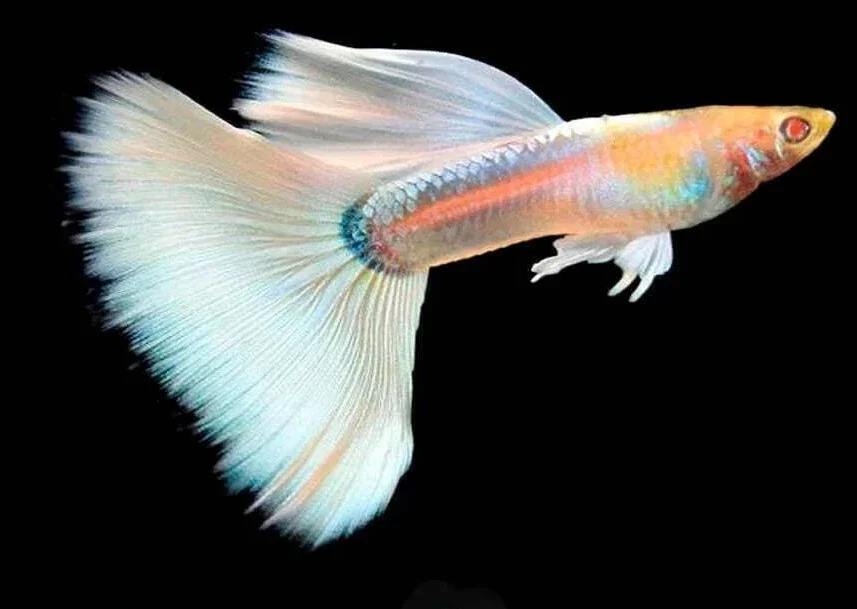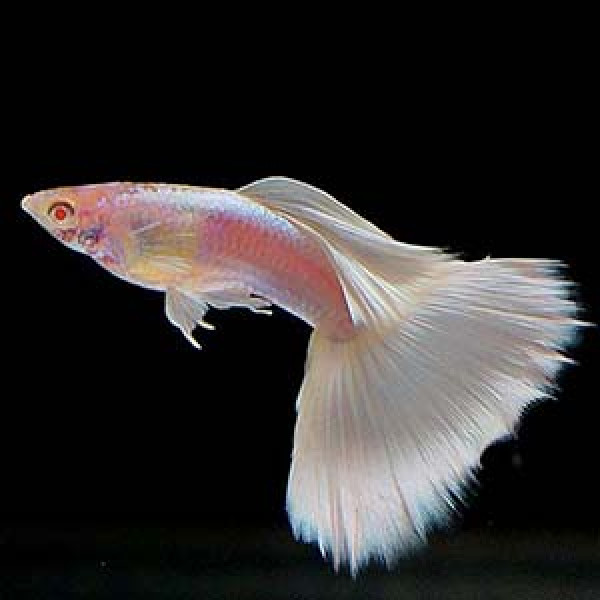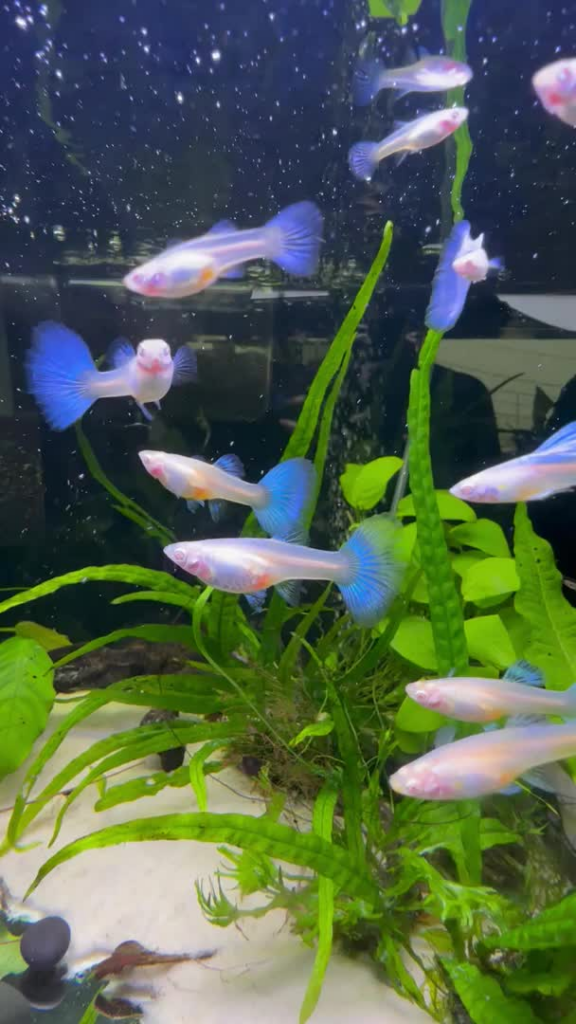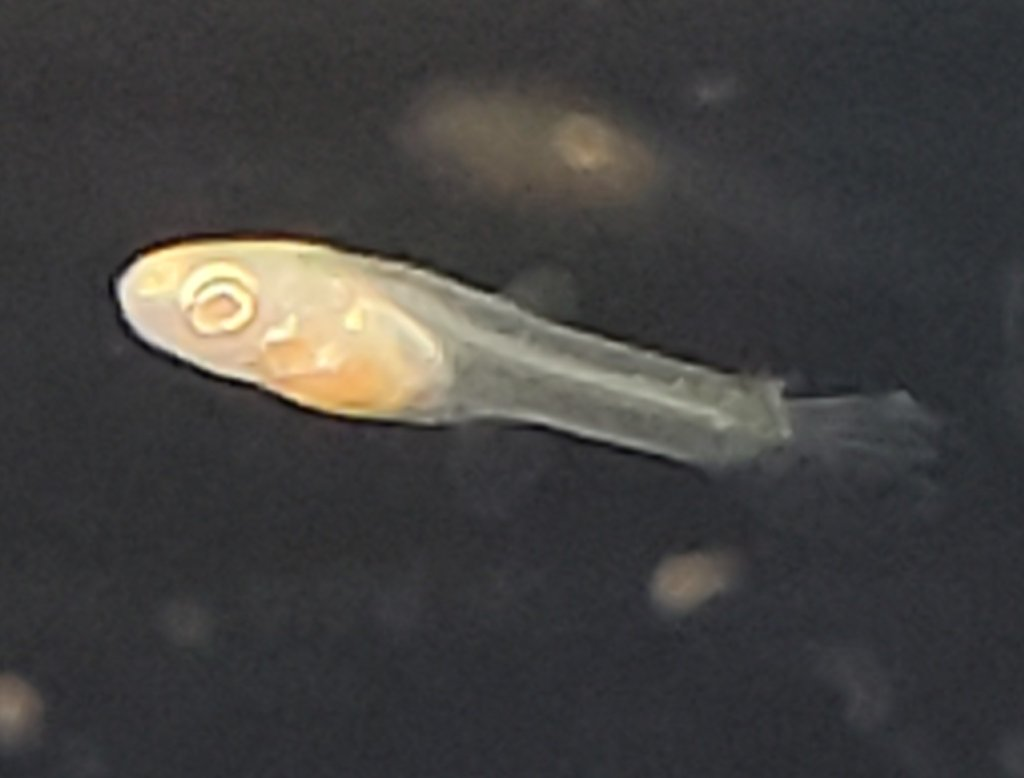Maintain the sensitive pale scales of Albino Guppies with these tested and trusted care tips, including recommendations for compatible tank mates.

The Unique Beauty of Albino Guppies
The love for rare or popular guppy varieties keeps growing by the day because of how easy it is to care for them despite their fancy features. As an aquarium enthusiast, if you’re looking for the next best unique aquarium fish for your tank, let me introduce you to the Albino Guppy.
This Albino fish with red eyes is a captivating small species sure to bring a new vibe into your tank. Its pale scales and elegant fins make it one of the most loved striking white guppies.
This care guide gives you the best practices for maintaining the Albino Guppy’s health and well-being.
Origins and Genetic background of Albino Guppies
Although they’re an ornamental species, the Albino Guppy genetics didn’t come from selective breeding practices. Instead, they’re a product of a natural mutation in fish that causes a lack of melanin and gives its scales a pale white coloration.
This Albino fish development was popular in Venezuela and Trinidad but has since migrated to other parts of the world; despite having these already unique albino traits, fish traders further experimented with its genes and created diverse colorations within the Albino phenotype.
That’s why today, there are several variations of the Albino guppy fish, as you’ll see now.
Distinctive Physical Features of Albino Guppies

When you look at the Albino Guppy’s appearance, you can split its distinctive physical features into four parts —
Size
Like every other guppy, the Albino variety is also small and doesn’t grow beyond 1 – 2 inches long. At best, it extends up to 3 – 4 inches when you include its tail and fin length, especially if it’s a delta or dumbo ear tail.
Coloration

Its pale white guppy features are the most distinctive physical trait of the Albino variety. Sometimes, it may have bright orange, red, or pastel shades on its fins, which add to its beauty, and other times, it’s pure white with no extra colors.

The Albino guppies with multiple colors are the variants made from selective breeding, as I explained earlier. However, you can also see a natural albino with other colors based on the reflection of the lighting in the aquarium. So, know the difference.
Eyes
Every albino guppy fish has contrasting red or pink eyes due to the lack of melanin in their bodies. It often creates a striking contrast with their bright and pale scales, but that’s not the best part of the red-eyed guppy traits.
Fins
If you’ve ever seen translucent fins in guppies, you can testify to their mesmerizing nature. It’s almost invisible in the water, especially clean waters, such that it feels like the water is an extension of the fish’s body, and most Albino guppies have this fin type.
They also have a range of fin shapes and patterns like other popular guppy varieties, from classic delta tails to exaggerated dumbo ears and elegant lyretails.
Whichever tailfin your Albino guppy fish has, best believe it adds to its beauty and requires special care and attention.
Essential Care Guidelines for Albino Guppies
Albino Guppy care essentials are multiple fold because they cover every aspect of their lives, from living environments to their feeding, health, growth, and overall wellbeing.
I’ll start by showing you what the ideal water conditions should be based on the freshwater habitat they naturally live in. Then, I’ll explain the best practices for maintaining Albino Guppy’s health.
Water Parameters
Albino guppy fish are hardy, but they require warm water with a temperature between 72 – 82℉. Set the alkalinity to 6.8 – 7.8 pH levels and keep the nitrite and ammonia levels low using a quality filter.
Because most guppies are small, you can keep a tank size of 10 gallons per fish, so a sponge or hang-on-back filter is ideal.
Lighting
Create a daily routine for your Albino guppies using moderate to low lighting with a 12-hour cycle. I didn’t say to use strictly low lighting because your Albino guppies still need light to enhance their color.
Be careful though with albinism comes light sensitivity. You should setup your tank decor to provide shaded hiding places from direct light which would help avoid burns or blindness.
Tank Maintenance
Once you’ve set the water condition and added a good filter to clean the leftover foods and waste, you must also do your part. Change 25 – 30% of the water at least once a week to ensure it stays clean.
Also, the substrates and decorations should be cleaned to prevent bacteria and fungus buildup.
Creating the Ideal Tank Environment for Albino Guppies

Building the perfect Albino Guppy tank setup is good for you and your pet because their well-being ensures you also enjoy having them around. When creating the ideal tank environment, you must always reference the Venezuelan and Trinidadian waters.
Here’s how you can achieve that:
Substrate
Let’s start at the base. Once you’ve set your water parameters in your 10-gallon/fish tank, use a fine substrate like gravel, smooth sand, or marbles for the bottom.
Because the Albino guppy has a sensitive scale and fins, choosing a fine substrate is essential to their physical health.
Decoration
Now, build on the substrate with realistic decor like live or silk plants, which are both aesthetic and functional pieces. Your Albino guppies can hide behind them to forage in the smooth substrate while it shields them from direct lighting.
Also, use driftwood, caves, and rocks to create a shelter for your pets when it’s time to sleep. Some beginner friendly aquarium plants you can use include java moss and hornworts.
Lighting Type
Remember how I recommended moderate to low lighting for your Albino guppy’s aquarium tank? Let’s talk a little bit more about that now.
LED lighting is the best type to use for light-sensitive fish care because you can regulate its reflection, and it aids live plant growth.
Filtration
The ideal filtration systems for guppies allow slow-moving water flows because strong currents will stress your small fish or suck them into the filter.
Feeding and Nutrition for Albino Guppies
You must focus on preserving coloration and other sensitive traits when feeding Albino fish, which is why the Albino guppy needs a balanced diet.
A healthy diet for Albino guppies would include proteins, vitamins, and minerals. You can get these nutrients from live foods like Brine Shrimp and Daphnia and high-quality flake or micro pellet foods.
It would survive on a regular guppy diet, but it would do best if you included special nutrition for white guppies in its meals. Some of them include vegetables like spirulina, blanched greens, and carotenoids to improve their skin coloration.
For more on feeding your aquatic pets check out The Ultimate Guide to Fish Food: Pros and Cons & Best Choices!
Feeding Frequency
Feed your Albino guppies two to three times daily and in only small quantities; they can finish within 3 minutes. It helps them digest their foods faster and eat without causing much mess from leftovers.
Also, not pacing your fish or portioning the food can lead to health issues like obesity and constipation.
Common Health Issues and Prevention Strategies
If you’ve followed the care guide so far, you’ve already done well in maintaining guppy wellness, but there’s still more work to do. Because of this species’ unique physical traits, they’re prone to certain Albino Guppy health concerns, which I’ll highlight now.
Ich (White Spot Disease)
Cause: Poor water quality, stress from overcrowded tanks and contact with infected fish.
Symptoms: white spots on the body.
Prevention: maintaining stable water conditions and quarantining new fish.
Treatment:
Fin Rot
Cause: Poor water quality or physical injury.
Symptoms: Frayed and Discolored fins
Prevention: Regularly check water parameters and provide a clean environment.
Treatment: Use wide-spectrum antibiotic cream.
Swim Bladder Disorder
Symptoms: Difficulty swimming and Floating or Sinking.
Cause: Overfeeding, Constipation and Sudden temperature changes.
Prevention: Avoid overfeeding and Ensure a varied diet.
Treatment: Fast the fish and regulate the temperature
Fungal Infections
Symptoms: Tiredness, irritability
Cause: Stress or injury.
Prevention: Maintain a stress-free environment by choosing compatible tank mates.
Treatment: Use anti-fungal medication.
General Care Tip
Always have routine health checks for your fish so that you can quickly note any physical and behavioral changes. They’re often the precursor to serious health complications but you can treat them with early detection. Also maintain regular water changes to promote a healthy tank.
Breeding Albino Guppies: Key Considerations

Breeding Albino guppies is a whole other task than caring for mature ones because these species are livebearers. That means they give birth to fry and not eggs, which makes their young more sensitive in their early stages.
Use these tested and tried successful guppy breeding tips to ensure you also get positive results.
Selecting Breeders
Choose healthy and vibrant adults when selecting Albino breeding pairs. They should be at least seven weeks old before they become breeders. You can identify the males from the females based on their physical appearance.
Males typically have colorful tails, while females are larger and rounder, with gravid spots on their bellies.

This video has been very helpful in identifying the sex of Guppies, I highly recommend it:
Breeding Setup
Use a separate breeding tank with plenty of plants and hiding spots for fry. You can also divide your main tank if it’s at least 30 gallons large since 10 gallons holds one Albino guppy. You can maintain similar water conditions as the main tank but add more plants and caves.
Mating Process
Introduce males to females and observe their mating behaviors. The male will fertilize the female Albino guppy after a short mating ritual. Remove males from the tank after breeding to prevent harassment, and wait for the females to give birth to their young between 24 and 28 days.
Once they give birth to the fry, remove the parents from the tank and move to fry care.
Fry Care

Albino guppy fry care requires specific actions like providing finely crushed flakes or specialized fry food for their diet and adjusting the water parameters.
Ensure they have plenty of hiding spots to avoid predation from larger fry as they grow older. Regularly check fry for health and growth, separating them by size to prevent bullying. Within seven weeks, they’ll mature and be ready to join the main tank.
If you’re wondering about the Albino Guppy behavior and whether it’s compatible with building a community tank, the answer is yes. This species is social and thrives in groups, but you must be careful when choosing tank mates.
Besides restricting their groups to 5 – 6 per shoal, you must also test the other fish for community tank compatibility. Pair Albino guppies with calm fish like tetras, rasboras, and corydoras if you want peaceful fish interactions in the tank.
Also note their peculiarities, like how the males can be competitive, so they need enough females to reduce stress and harassment among them. A good ratio is three females to one male.
Keep enough open swimming areas in the tank to encourage natural schooling behavior and give your pets a sense of security.
Conclusion
That’s the end of today’s Albino Guppy care overview. I hope you’ve enjoyed learning about this interesting species as much as I’ve loved sharing these expert guppy care tips with you.
You have all the necessary tools you need for adding Albino guppies to your tank without making beginner mistakes. Let’s do a quick recap to see if you’re ready for enhancing aquarium beauty:
- Are your tank requirements optimal?
- Do you have the proper decor?
- What would your Albino Guppy eat?
- Are they living alone or with other species?
If you have the answers to these questions (detailed in this article), you’re ready to keep an Albino Guppy fish.


